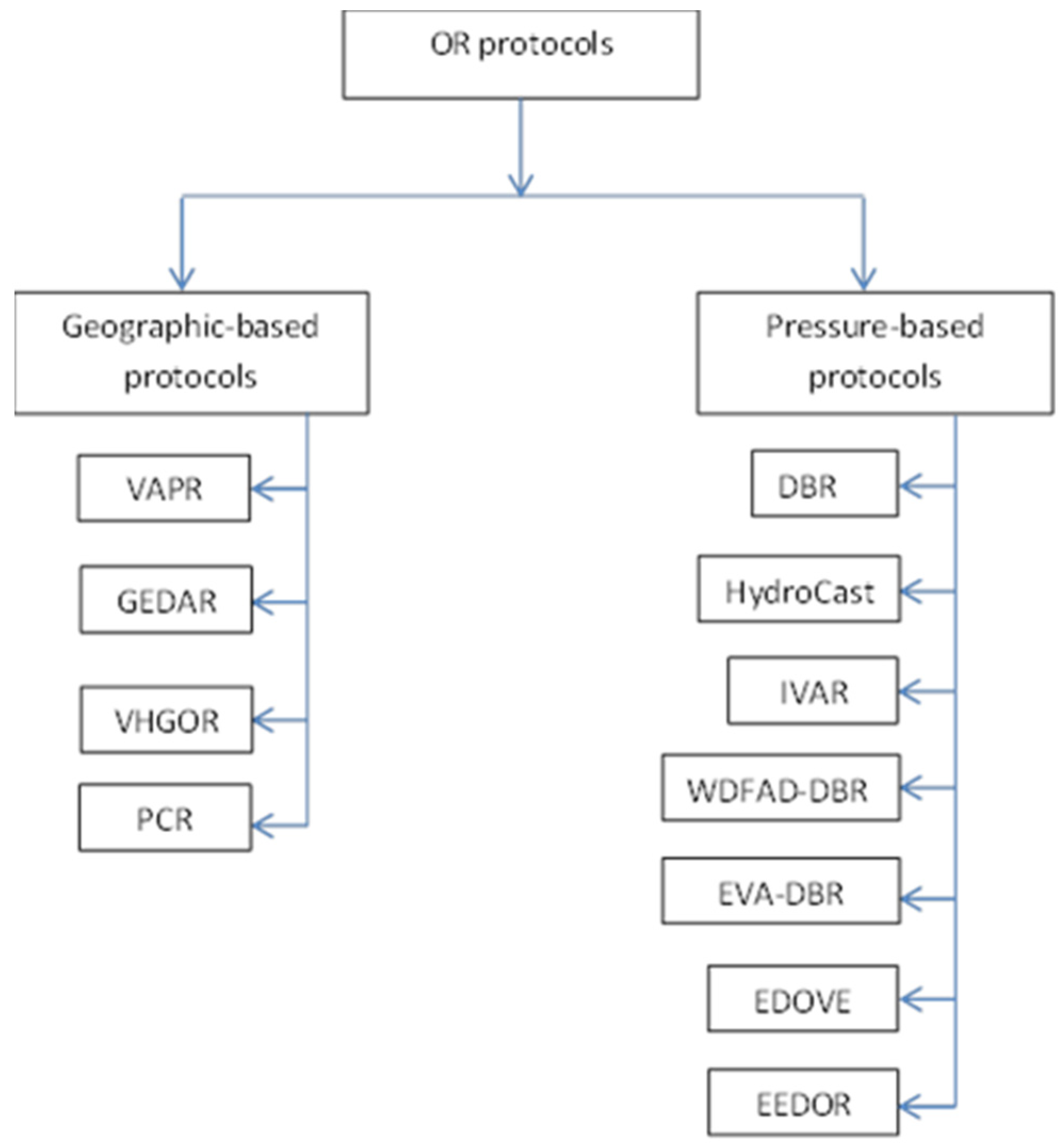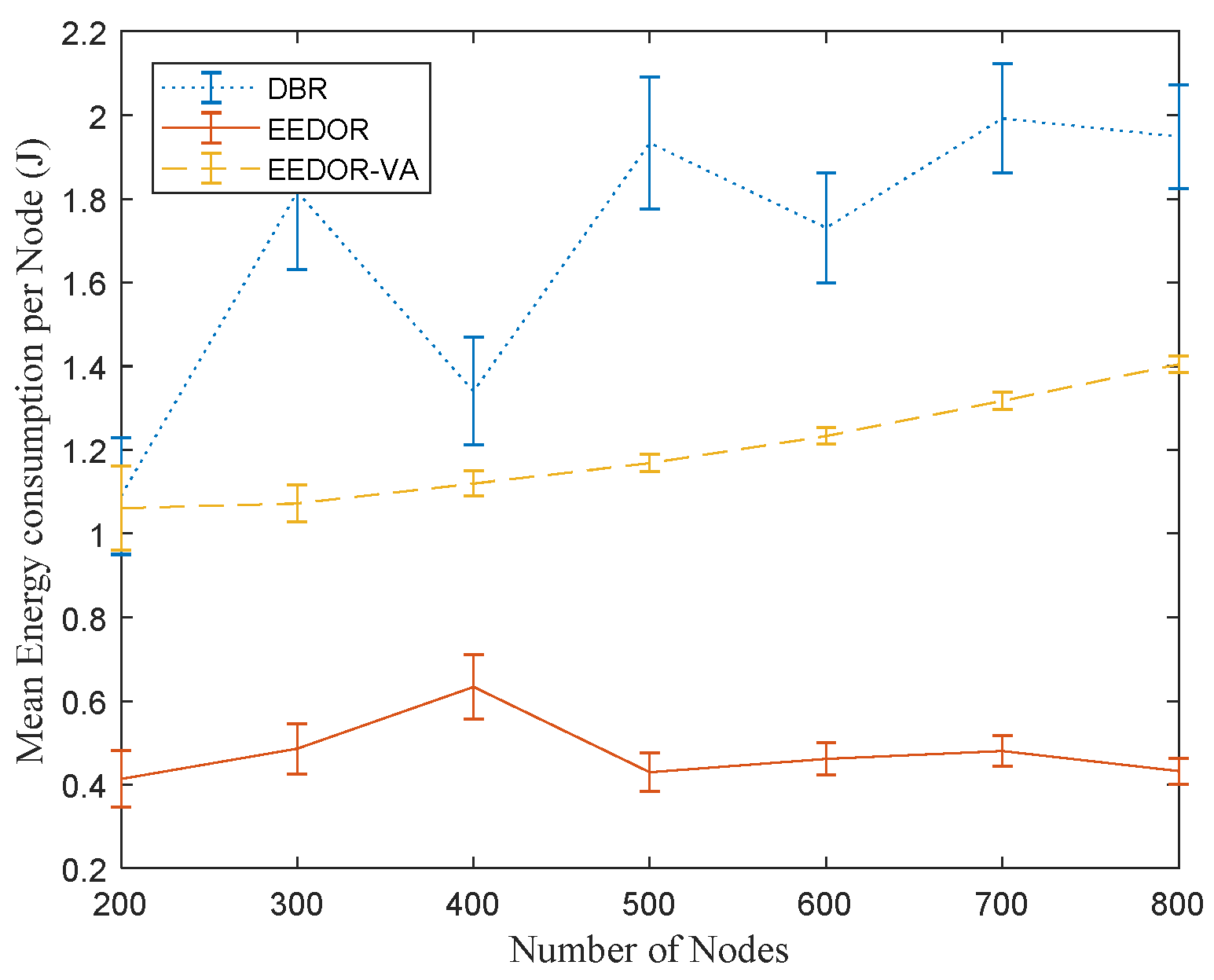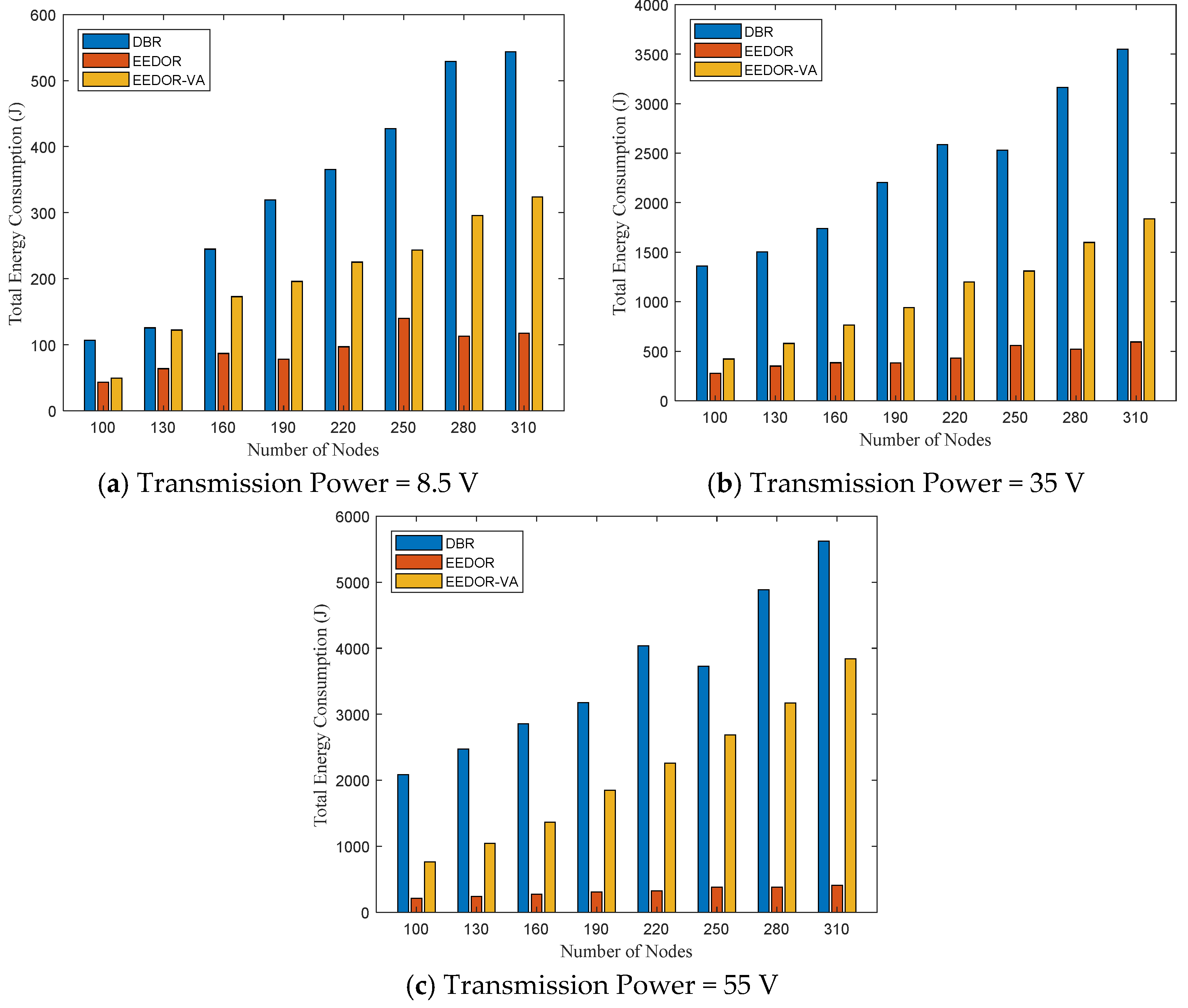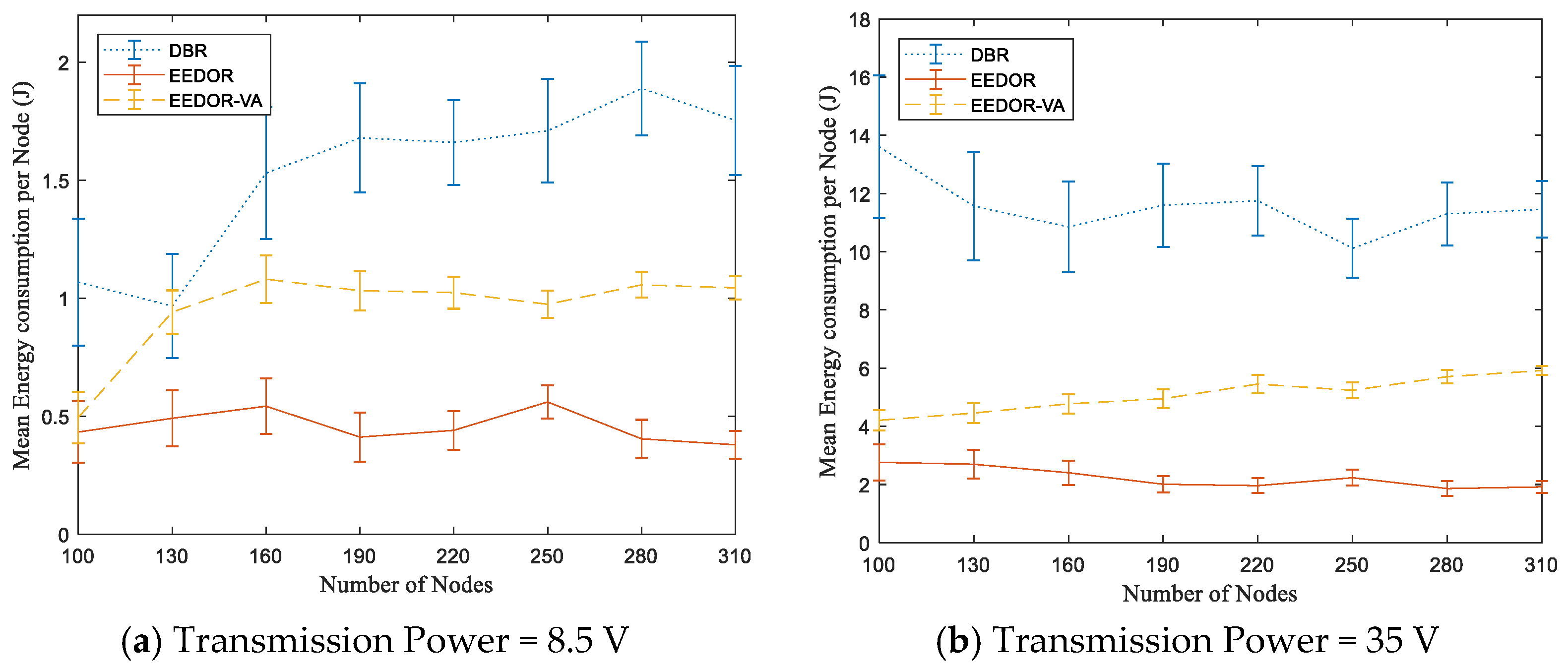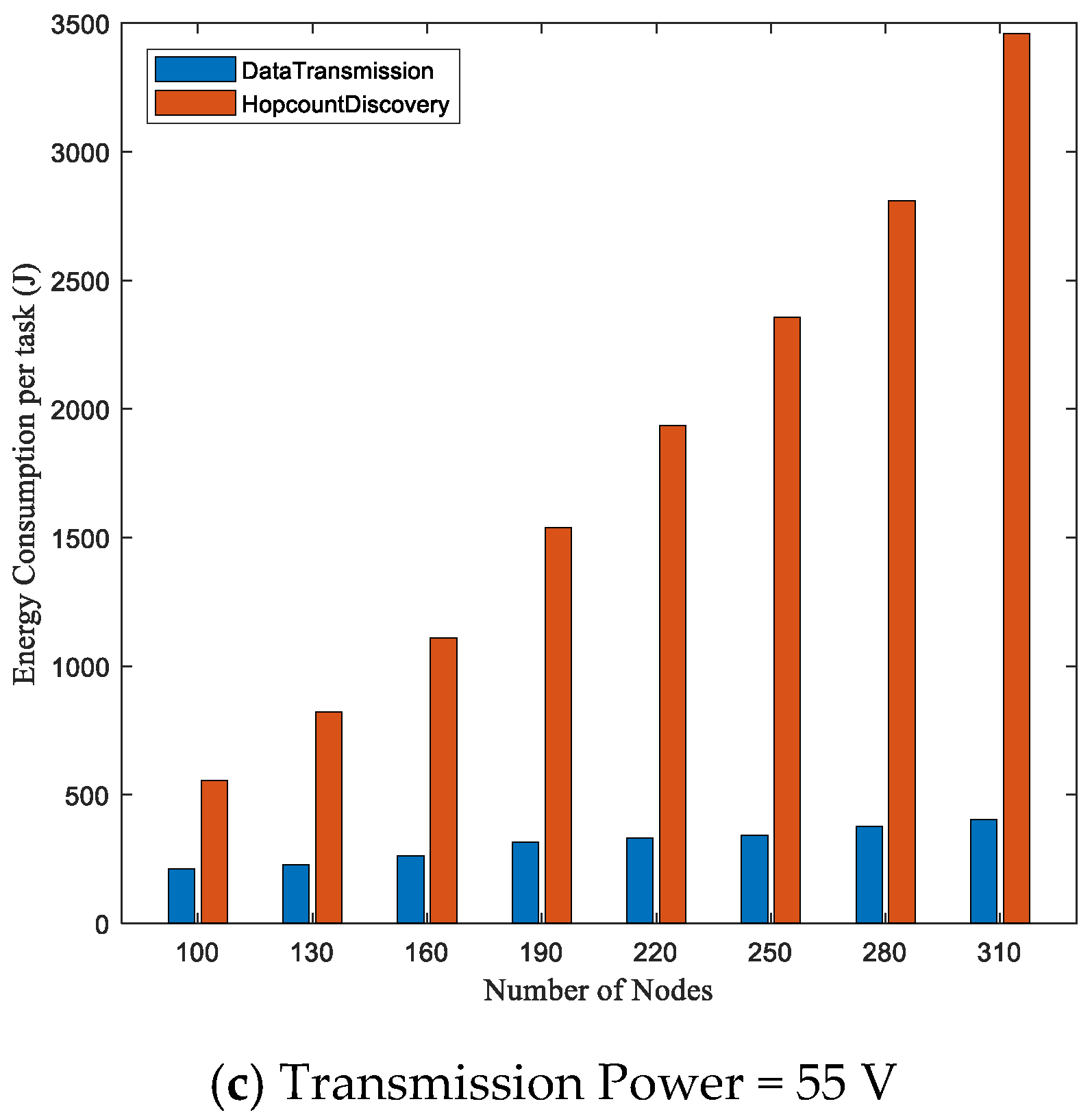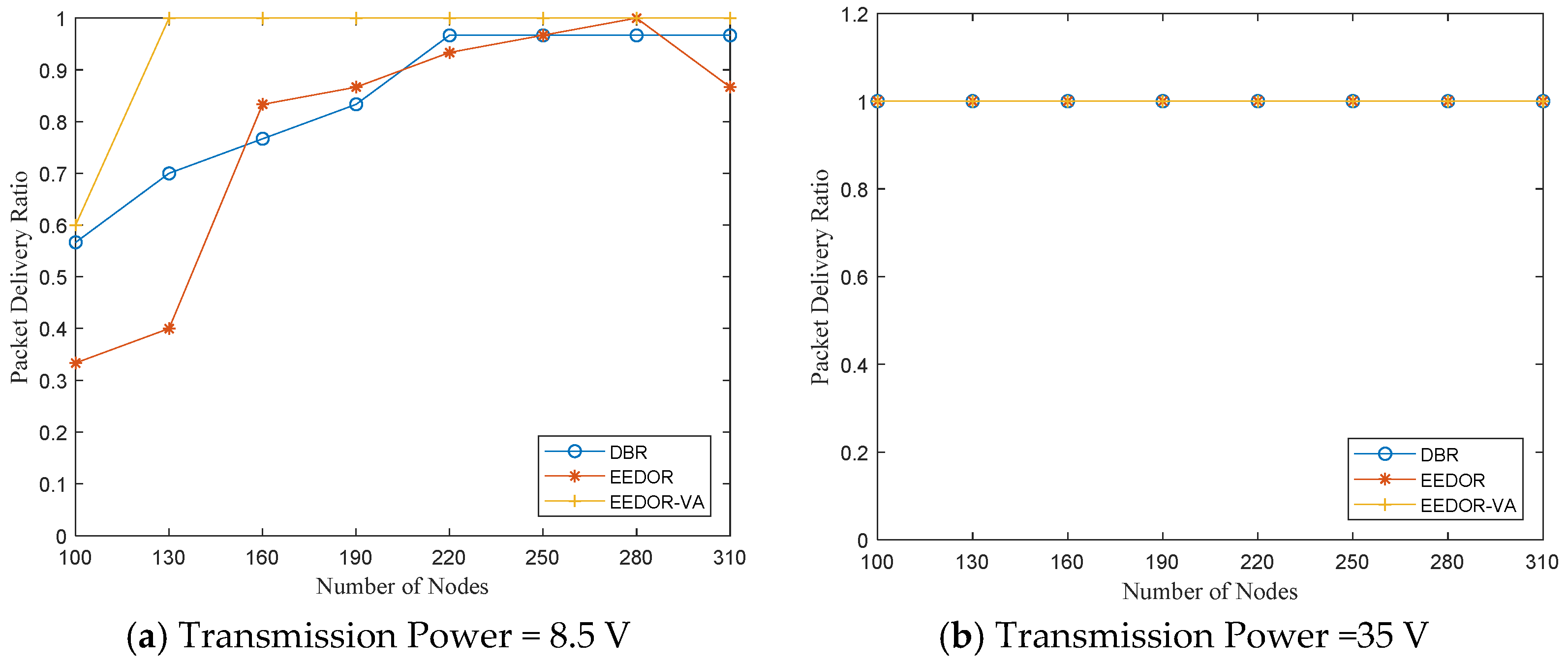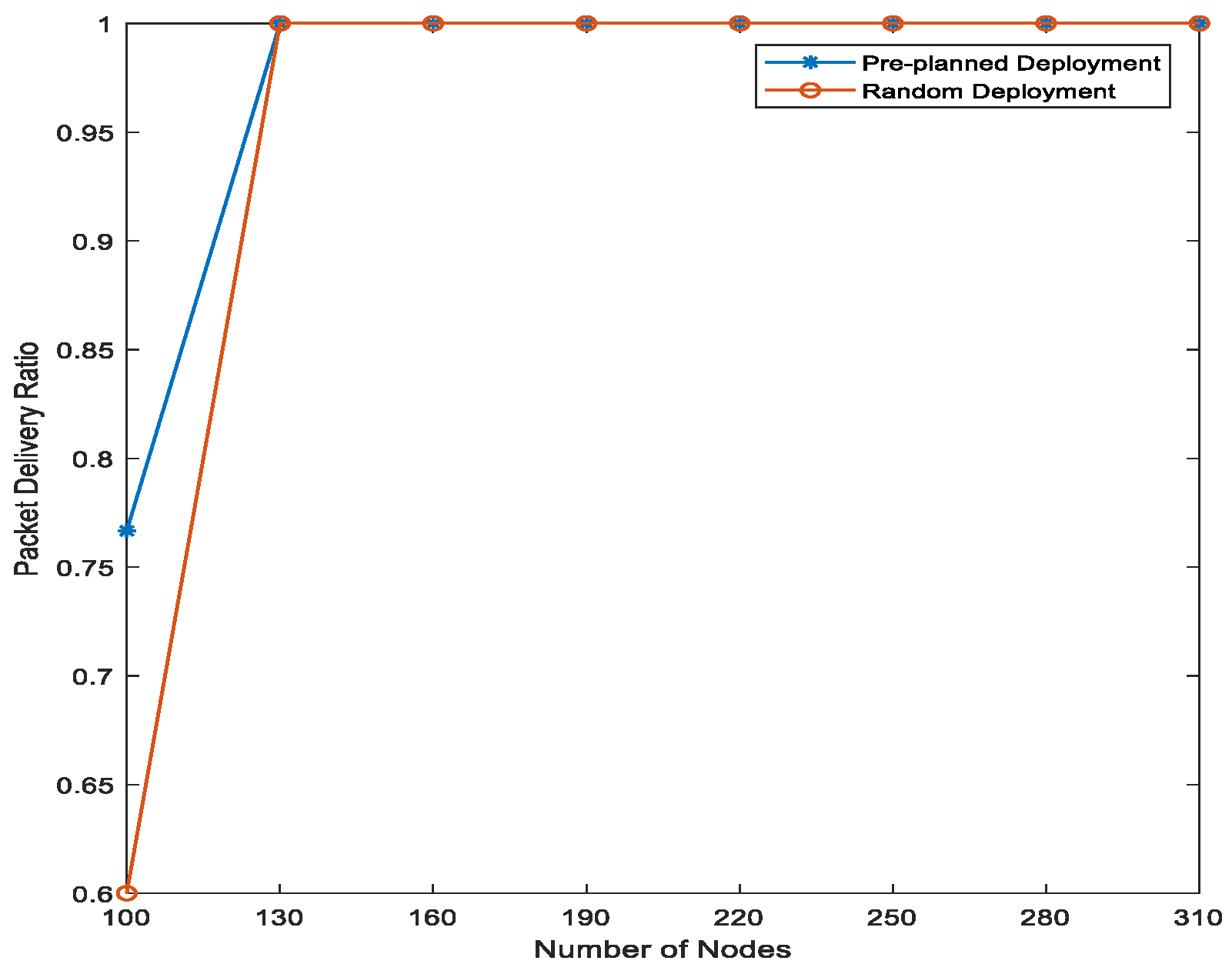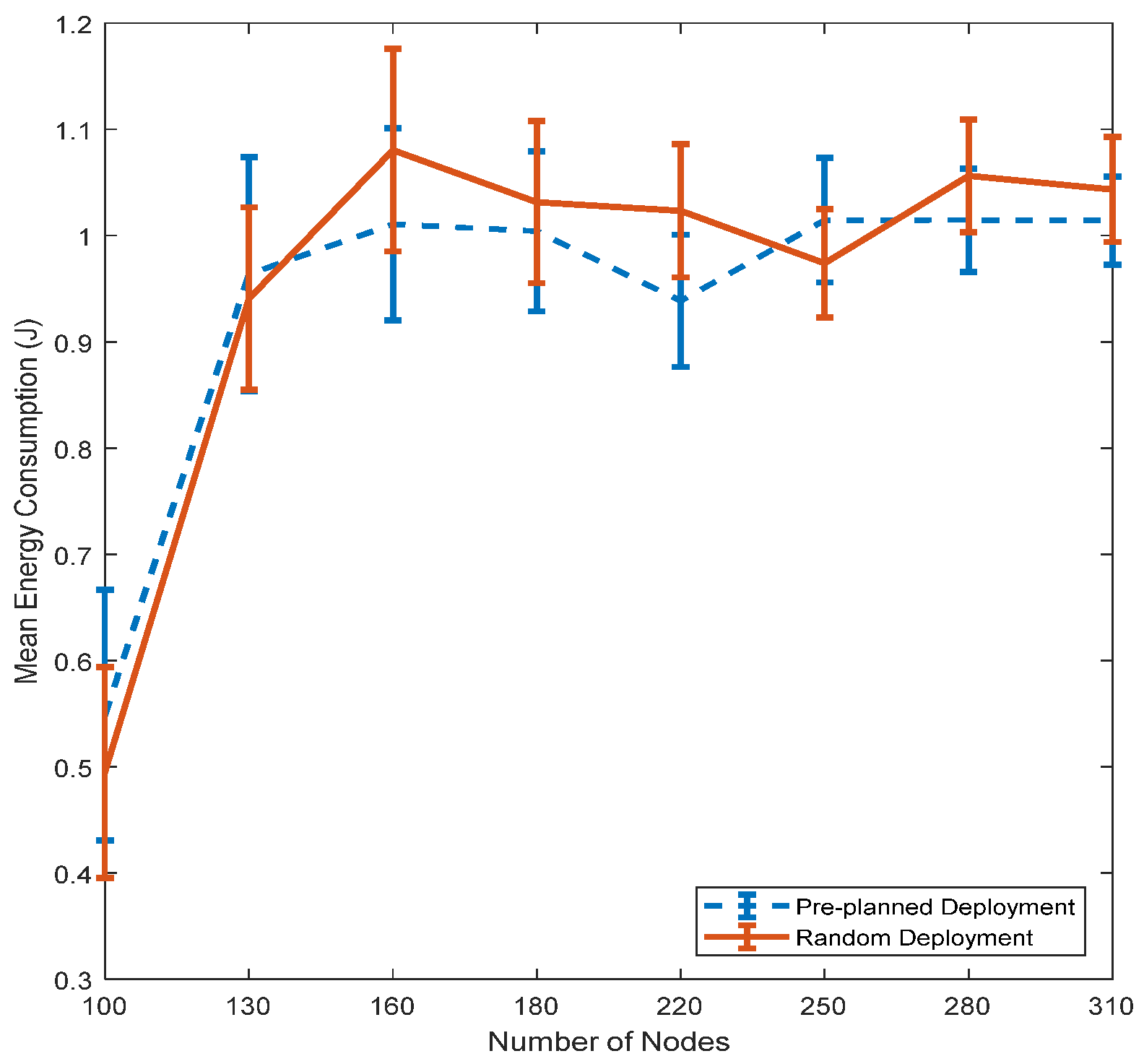1. Introduction
Water covers more than two thirds of the earth’s surface. This environment is very important for human life since it plays an important role as a transportation medium and affects the earth’s climate as well as global production because of its richness in natural resources. Due to these reasons, lately, researchers have been giving more attention to Underwater Sensor Networks (UWSNs) to investigate and discover the unexplored submerged underwater areas and empower numerous applications such as resource exploration, oceanographic data collection, pollution monitoring, tactical surveillance, oil/gas spills monitoring, etc. [
1,
2,
3,
4,
5,
6,
7]. To make such applications realistic, effective communication protocols are fundamentally required to complete the communication procedure between the underwater devices successfully. Many communication protocols have been proposed to address different Terrestrial Wireless Sensor Networks (TWSNs) issues [
8,
9], which make such networks widely investigated. On the other hand, many UWSN issues remain open and need more investigation.
UWSNs have different characteristics and features when compared to TWSNs [
10]. These differences can be seen in many aspects. First, UWSNs use acoustic signals for communication instead of radio signals used by TWSNs. Second, the UWSNs’ topologies are more dynamic than the topologies of TWSNs. Third, the underwater deployment is unattended and comparatively sparse as compared to TWSNs. Fourth, node localization in UWSNs is hard compared to node localization in TWSNs. Fifth, underwater sensor nodes have more costly hardware than terrestrial ones, and they are resource limited (i.e., memory and energy). Moreover, it is hard to replace or recharge their batteries after deployment.
As we mentioned above, UWSNs use acoustic signals while TWSNs normally use radio signals. While the radio signals do not propagate well and suffer from attenuation in underwater environments, the acoustic signals perform wireless communication in underwater environments with satisfactory range, a smaller amount of attenuation and higher reliability [
11]. The acoustic signal is affected by underwater characteristics such as strong attenuation and ambient noise, time-varying multipath propagation, and low-speed sound propagation (speed of sound in water is ≈1500 m/s, which is five orders of magnitude lower than the radio signals used in TWSNs) [
7,
12]. These underwater properties result in high delay and error rate, temporary loss of connectivity, limited bandwidth capacity, and high-energy communication cost.
Since UWSNs use acoustic signals in their communication, the straightforward application of the traditional TWSN protocols to UWSNs reduces network performance [
2,
3,
11]. Consequently, several underwater protocols were proposed to improve communication in underwater networks. These proposed protocols for UWSNs have considered various underwater parameters and addressed different problems. Improving network lifetime is a significant objective in UWSNs since replacing or recharging batteries of underwater nodes is a very expensive and difficult task in the harsh underwater environment. Two or more nodes may become unreachable as node battery energy depletes, causing a topology partition that results in the void area problem. This issue has attracted the attention of many researchers.
In addition to the void zone problem, acoustic signal fading degrades routing protocol performance. Opportunistic Routing (OR) has been proposed as a novel technique to improve network function by mitigating high bit errors and losses due to shadow zones, limited bandwidth, high power consumption, and signal spreading [
6].
It is known that in wireless networks the energy expended by sensor nodes in transmitting a data packet is more than the energy expended in receiving it. Hence, to improve the network lifetime, save the network resources and keep network connectivity, the rate of node energy consumption should be decreased by reducing the number of transmissions and therefore reducing the number of packets that must be forwarded from a source towards a sink(s).
In summary, harsh underwater environment characteristics, underwater sensor nodes’ limited resources and acoustic signal limitations increase the probability of bit errors, packet loss and network partition, decreasing network performance. The possibility of addressing these challenges using promising OR features motivated us to develop a void avoidance routing protocol for UWSNs. This protocol increases network performance by excluding all the routes that would lead to the loss of data packets.
In this paper, we propose a novel reactive routing protocol for UWSNs that addresses the void area problem. Energy Efficient Depth-based Opportunistic Routing with Void Avoidance for UWSNs (EEDOR-VA) utilizes the node’s hop count from a sink to select a next-hop forwarder set that can continue forwarding the packet towards the sink(s). In EEDOR-VA, the low priority nodes suppress their transmissions whenever they sense the same packet was sent by a high priority node to avoid redundant transmissions and their related costs. The proposed protocol’s novelty lies in a hop count discovery mechanism inspired by the Dynamic Source Routing (DSR) algorithm proposed in [
13] to update a node’s hop count from the sink and integrating hop count discovery with a novel OR technique that comprises two building blocks—candidate forwarding set selection and candidate set coordination [
14]. Instead of the periodic messages from the sinks implemented by most of the routing protocols, we propose a hop count discovery process that consists of Hop Count Request (HCREQ) and Hop Count Reply (HCREP) procedures to find the hop count of the sensor nodes. The idea is to remove void/trapped nodes that are in the current packet holder node’s neighborhood from that node’s forwarding set. The simulation results of low and high density scenarios showed that EEDOR-VA is able to decrease the total energy consumption, reduce the number of transmitting nodes and increase the packet delivery ratio.
This work enhances our previous routing protocol [
15] by designing an opportunistic routing protocol to cope with underwater acoustic channel weaknesses and address the void area problem in underwater network scenarios.
Our new protocol is better than existing underwater routing protocols mainly by implementing the hop count discovery, which reduces the network overhead caused by periodic beacons and retransmissions and improves the packet delivery ratio while also increasing energy efficiency, since packets are only transmitted if a path is found from the source to the sink(s).
More discussion on the EEDOR-VA contributions is listed below:
Implementing the proposed hop count discovery technique inspired by DSR instead of flooding periodic beacons widely used in the literature ensures less network communication overhead and lower network resource consumption.
The small size of proposed HCREQ and HCREP messages that are used to discover the hop count between the packet generator and the sink(s) reduces the collisions and network overhead and decreases the total energy consumption.
Forwarding set coordination based on the proposed waiting time supports balancing energy consumption by suppressing retransmissions.
The development of the forwarding set selection procedure excludes all void/trapped nodes that may lead to a void area from the data routing path. Our proposed protocol checks the node reachability to the sink and updates in-route node hop counts. If a node does not have any path that facilitates forwarding the packet toward the sink(s), the node is dropped from the forwarding candidate set.
Multiple opportunistic routing paths established through hop count discovery increase the packet delivery ratio.
Our novel protocol is a reactive loop-free OR protocol proposed to enhance EEDOR by addressing the void area problem based on the hop count discovery of the source node. This approach improves the packet delivery ratio by avoiding paths that have a large number of hops that increase the packet error rate as a result of packet collisions.
The rest of this paper is organized as follows. In
Section 2, some of the well-known related works in the area of void avoidance are reviewed. The details of our protocol are presented in
Section 3. The simulation results of different scenarios are presented in
Section 4. Finally, the conclusion of our study is provided in
Section 5.
2. Related Works
A number of protocols have been proposed that use OR techniques to deal with the void communication area problem. In this section, we first give a brief classification of routing protocols found in the literature that address the void problem as well as other comparative protocols. We then present a review and discussion of these protocols and their benefits and drawbacks.
The existing OR protocols in UWSNs can be classified into two main categories based on their positioning information: Geography-based routing protocols and Pressure-based routing protocols. This classification can be seen in
Figure 1.
In the Geography-based category such as [
16,
17,
18,
19], selecting the forwarding set candidates and making the forwarding packet decisions in OR requires information about the geographic location of sensor nodes, while in the Pressure-based category, as in [
15,
20,
21,
22,
23,
24,
25], the depth information of nodes is needed to select the next forwarding set candidates and make forwarding packet decisions.
Void-Aware Pressure Routing (VAPR) [
16] is an anycast soft-state routing protocol that was proposed to address the void node issue in UWSNs. VAPR consists of two stages: an enhanced beaconing stage and an opportunistic data forwarding stage. Instead of encountering a void area and then implementing a recovery mode, VAPR takes advantage of geographic routing and employs the regular beaconing messages method, which includes some useful local information about the node to be used in the forwarding set selection stage. VAPR suffers from high-energy consumption since it measures the distance to the neighboring nodes and uses enhanced beaconing to exchange node information between the neighbors periodically.
In [
17], Geographic and opportunistic routing with Depth Adjustment-based topology control for communication Recovery (GEDAR) utilizes the greedy forwarding technique by knowing the position information of each current forwarding node, its neighbors, and the known sink. GEDAR is a sender-side OR technique, where the forwarding set of candidates is determined in each hop by the sender node. GEDAR uses network topology control techniques to increase the connectivity of the network and reduce the number of packet retransmissions. Moreover, the topology control method is also utilized to address the void zone problem. On the other hand, the depth adjustment technique used by void nodes to move to a new depth that allows them to communicate with other node(s) consumes a significant amount of energy. Another drawback of GEDAR is that sensor node energy is not considered when forwarder nodes are selected, which may result in poor forwarder node selection.
Void handling using Geo-Opportunistic Routing in underwater wireless sensor networks (VHGOR) [
18] adopts Geography-based Opportunistic Routing (GOR) to forward data packets to reach the destination over multi-hops. It is a heuristic protocol implemented with two methods to form optimal forwarder selection. The first metric is Opportunistic Routing based Expected Packet Progress (OREPP), which is calculated based on the difference between the geographic distance between the source and destination, and the geographic distance between any node and the destination, residual energy and packet delivery probability. The second metric is Node Closer to the Destination (NCD); NCD can be defined as the best node with maximum OREPP to forward the current packet. VHGOR uses a greedy forwarding approach to advance the packet towards the destination, and if a packet gets into a void node, the protocol switches to the void mode. The limitations of VHGOR include consuming restricted resources such as node memory, through maintaining a neighboring table, and the node energy through node beacons.
Recently, a novel power control-based opportunistic (PCR) routing protocol for internet of underwater things (IoUTs) was proposed in [
19]. To achieve energy-efficient data delivery in IoUTs, the authors designed an opportunistic routing protocol that includes transmission power control. In PCR, each node considers more than one transmission power level to choose its candidate set for each next-hop, and then the energy waste for each candidate set is calculated to determine the appropriate transmission power level and the next-hop forwarding set. The packet delivery ratio is increased by modifying the transmission power level at each hop in order to choose the appropriate candidate node set from the sender neighbors to continue forwarding the data packets to reach the sink(s) on the water surface. PCR also reduces the transmission power level when the number of deployed nodes is increased to reduce the number of retransmissions, which decreases the energy consumption in some cases. However, as we can see from the results presented, the energy consumption is greater than that in the compared related works, which will affect the network lifetime.
The Depth-Based Routing (DBR) presented in [
20] was the first OR protocol proposed for UWSNs using sensor node depth. In DBR, the current forwarding node uses the flooding technique to send the packet to its neighbors. The receiving neighbors then decide to be a forwarding candidate by comparing their depth with the depth in the received packet. The depth threshold is also implemented during the forwarding set formation to select the nodes that are far from the current forwarder to continue the forwarding process. The holding time used to manage the coordination phase between the forwarding nodes is determined based on node depth. Using only the depth of the sensor nodes as a metric for forwarding set selection reduces the protocol’s performance because the nodes with smaller depths are involved in the forwarding process most of the time. Therefore, such nodes drain their energy before the other nodes in the network, which generates void zones. Moreover, the DBR flooding technique increases the probability of packet delivery to the surface but also increases redundant packets and packet retransmissions. Consequently, an extreme amount of energy will be consumed. In DBR, redundant packets and packet retransmissions happen because of the node’s holding time. That is, nodes may have the same depth, and using only the depth in calculating the hold time will give a number of nodes the same transmission times.
In [
21], the Pressure Routing for Underwater Sensor Networks (HydroCast) protocol is presented. HydroCast applies only the local information of the topology to form a cluster with nodes excluding hidden-terminal among them, and at the same time maximizing the Expected Packet Advance (EPA) of this cluster. In HydroCast, the current forwarder node needs to know the two-hop connectivity and the pairwise distances for the neighboring nodes. Nodes in the forwarding set are prioritized using a distance-based timer approach that results in the most distant node from the source having the shortest timer, and so on, to help in scheduling the transmissions and suppressing collisions. HydroCast addresses the void area issue using an OR approach, which also enhances the packet delivery ratio with small end-to-end delays since a subset of the neighboring nodes simultaneously receive the data packet properly. However, as a result of using OR, HydroCast suffers from redundant packet transmissions where a data packet may be delivered to the sink multiple times, causing the depletion of network resources. In addition, implementing the recovery mode increases the energy cost, and the simulation results presented in the paper do not show any details about the energy consumed by the pressure sensor in order to find its depth.
Inherently Void Avoidance Routing Protocol for Underwater Sensor Networks (IVAR) [
22] is a receiver-based forwarding protocol where the forwarding node does not need to store its neighbor’s information. In IVAR, a hop-by-hop forwarding set selection technique is used to forward the data packets from the sensed node to the sink. Each packet holder uses local information of hop distance and packet advancement to determine its own forwarding set. The nodes in these forwarding sets are given a priority depending on two metrics to forward packets: their hop count as a first metric and their depths as a second one. IVAR suffers from redundant packet transmission due to a hidden node problem. Consequently, redundant packet transmissions lead to an increase in energy consumption.
In [
23], another pressure-based routing protocol is described, namely weighting depth and forwarding area division DBR routing protocol (WDFAD-DBR). To increase the reliability of the packet transmission and decrease the probability of the void area problem, WDFAD-DBR uses the weighting depth difference of two-hop nodes to construct its routing decision. Broadcast control packets and acknowledgment messages (ACKs) periodically consume the node’s battery and memory. Duplicated packets are handled by dividing the forwarding area and using a neighbor node prediction mechanism that helps to reduce the energy consumption. Void holes are avoided by using the depth of the expected next hop. However, retransmission is required if the best forwarding node fails to transmit the packet. Additionally, routing flexibility might be affected due to choosing a fixed primary forwarding area to form the forwarding set so that a void area is not dealt with completely since trapped nodes are not eliminated from the forwarding set.
The Energy-efficient and Void Avoidance Depth Based Routing (EVA-DBR) protocol was proposed in [
24]. The EVA-DBR routing protocol consists of two phases: an updating phase and a routing phase. The protocol depends on the information broadcasted periodically in the updating phase from the neighbor nodes that are one-hop away from the source node for void detection and bypassing in the routing phase. Using a forward area resizing technique helps in addressing the hidden node problem and, in some cases, can also detect the void and trapped nodes before the data packet gets caught in a void node. However, in both phases of the protocol, periodically broadcasting neighbor information consumes node resources and many duplicate packet transmissions seem to happen in sparse networks. In addition, the hidden node problem may be present if the forwarding range is chosen to be more than half of the transmission range.
In [
25], a protocol called the Energy and Depth variance-based Opportunistic Void avoidance (EDOVE) protocol was presented based on WDFAD-DBR, the work presented in [
23]. The protocol handles the void area problem by choosing the forwarder candidates among the total distributed nodes that have a large residual energy and have several nodes in their transmission range (neighbors). To obtain this useful node information, each node in the network topology exchanges its information with its one-hop neighbors through the neighbor request and neighbor acknowledgment packets, and each node has to maintain its neighbor table. EDOVE considers energy level as one of its parameters to help in reducing energy consumption and avoiding energy holes. However, exchanging neighbor information and maintaining the neighbor table consumes node resources. The protocol also suffers from duplicate packet transmissions, which increases energy consumption. Moreover, the void area is not handled completely since the protocol only addresses energy void holes.
Most recently, an Energy Efficient Depth-Based Opportunistic Routing protocol (EEDOR) was presented in [
15]. EEDOR is a hybrid forward set selection procedure where the forwarding candidate set is selected in a cooperative way between the current forwarder node and its neighbors. In EEDOR, the current forwarder node’s forwarding set contains only the candidate neighbors with less depth than the current forwarder. Moreover, the nodes in the forwarding candidate sets are given priorities based on their depths. These priorities are used in the novel holding time proposed by the protocol to determine the transmission time for each node in the forwarding set candidates. The proposed holding time reduces the collisions and retransmissions issue caused by multiple nodes having equal transmission times. The protocol enhances the lifetime of UWSNs, decreases the total energy consumption and reduces the number of nodes involved in the packet forwarding procedure. In contrast, EEDOR suffers from a low packet delivery ratio in the simulated network topology. In addition, the protocol does not address the void area problem.
Advantages and disadvantages of the OR protocols for UWSNs related to our work discussed above are summarized in
Table 1.
3. EEDOR Void Avoidance with Hop Count Discovery Mechanism
3.1. Network System
Our UWSN architecture model consists of a number of sensor nodes randomly deployed underwater in different depths and multiple immobile sinks located on the water’s surface. The sinks are equipped with both radio modems to communicate with each other and/or with a base station, and acoustic modems to communicate with the underwater sensor nodes. The underwater sensor nodes consist of two types: nodes that participate in packet forwarding and nodes that do not. Nodes that participate in packet forwarding are the source node, next forwarder nodes, and forwarding candidates. Nodes that do not participate in packet forwarding are void nodes, trapped nodes, and idle nodes. Each type of node is defined as follows:
In our proposal, we improve the routing performance of EEDOR presented in [
15] by using on-demand hop count discovery to prevent the void and trapped nodes from participating in the data packet transmission, to save the network resources. The network scenario shown in
Figure 2 illustrates our model and the routing paths.
In this model, nodes are homogeneous in terms of energy consumption and transmission range. When the packet holder (Pholder) node has a packet to send to the surface sinks, it will use the neighboring relay nodes determined by the hop count discovery process to deliver this packet. The Pholder and its neighboring relay nodes use acoustic signals to transmit their packets. We used the Thorp propagation model described in the next section to model the underwater acoustic channel.
3.2. Acoustic Channel Model
Sensor nodes in wireless sensor networks are battery-powered devices. Nodes in UWSNs consume a significant amount of energy because of the underwater acoustic channel characteristics. When the sensor nodes deplete their batteries, the sensor networks eventually cannot operate correctly. In this section, we describe the path loss and ambient noise of the underwater acoustic channel as in [
26,
27].
The sonar equation, which characterizes the signal-to-noise ratio (
SNR) of passive sonar, is shown in Equation (1) below, as presented in [
26,
28,
29,
30]:
The model starts with the passive sonar equation, which describes the
SNR in dB:
where
SL is source level,
TL is transmission loss,
NL is noise level and
DI is directivity index.
DI = 0 as denoted in [
29].
Source Level (SL): Referring to [
30], we can calculate
SL as:
where
Ptx is the total acoustic power of the source.
Transmission loss (TL): Referring to [
26,
31] we can calculate the
TL as the sum of both spreading and absorption loss, as follows in Equation (3)
where
d is the distance in
km,
α is the absorption coefficient, expressed in Equation (4), and
k is the spreading factor (
k = 1 is cylindrical,
k = 2 is spherical, and
k = 1.5 in practical spreading).
Absorption loss (α): We use Thorp’s expression since it is widely used in the publications [
26,
29,
30]. According to [
26], the absorption coefficient (
α), which depends on frequency (
f), can be defined and expressed as in Equation (4)
where
f is the frequency in kHz.
Noise Level (NL): The noise levels in the ocean have a serious influence on the acoustic channel; they can be divided into [
30,
31,
32]:
Ambient Noise: This noise is due to seismic and biological phenomena and water movement, which includes tides, current, storms, wind, and rain.
Man-made noise: This is unnatural noise caused by human and shipping activity such as pumps, reduction gears and power plants, especially in areas encumbered with heavy vessel traffic.
Four sources of noises are used to model the noise level, namely: turbulence (
Nt(
f)), shipping (
Ns(
f)), wind (
Nw(
f)), and thermal (
Nth(
f)) noises. Equation (5) shows the calculation of these four factors in dB/Hz.
where
s defines a shipping activity factor value ranging from 0 to 1,
w gives the wind speed in m/s and
f is the frequency in kHz.
Then, the overall noise is expressed in Equation (6)
where
B is the receiver bandwidth in Hz.
Bit Error Rate (BER): We assume that the underwater acoustic micro-modem uses binary phase shift keying (BPSK) modulation [
17,
19,
33]. Accordingly, the bit error rate (
Pe) of BPSK in an underwater Rayleigh fading channel can be calculated as in [
33]:
where
SNR is the signal-to-noise ratio defined by Equation (1).
Probability of Successful Packet Delivery: For a packet of
m bits, the probability of successful packet delivery (
P) is:
Figure 3a illustrates the impact of the channel noise level and the transmission loss on
SNR for various values of wind and shipping noise. The impact of these effects on packet delivery probability is shown in
Figure 3b.
3.3. Description of the Proposed EEDOR-VA Protocol
In this paper, we extend our previous EEDOR protocol and enhance the network performance by addressing the void area problem.
Our technique to address the void area problem consists of bypassing the void and trapped nodes. EEDOR-VA makes a routing decision according to the nodes’ reachability to the surface sink(s). Our novel hop count discovery process was inspired by the source route discovery process used in DSR. In EEDOR-VA, Hop Count Request (HCREQ) and Hop Count Reply (HCREP) messages are used to update the node’s hop count to the reachable closest sink. The void and trapped nodes in the transmission range of a source and/or relay nodes do not reply to the HCREQ message and are excluded from being one of the forwarding candidates, so the data packet is not trapped in these nodes. Therefore, each Pholder can form its forwarding set easily. Since the presence of the void area can prevent communication between some of the network nodes, which reduces the routing protocols performance, our goal is to increase the routing performance through developing a routing protocol that gains a high packet delivery ratio with less energy consumption by selecting the shortest routing path. To complete a successful transmission, each packet must reach the next forwarder successfully at each hop and one of the sinks at the end of the forwarding procedure. The information received from the hop count discovery algorithm is used to assist the sensor nodes to update their hop count from the sink(s) and exclude the void and trapped nodes in the Pholder nodes’ transmission range. The hop count discovery mechanism in EEDOR-VA eliminates periodic beaconing and its associated costs.
The main idea of EEDOR-VA is to determine multiple loop-free paths between a source node and a single sink or multiple sinks on the sea surface. This is achieved through a hop count discovery procedure inspired by the DSR algorithm to update the nodes’ hop-count. These multiple routes make it easy for the protocol to modify the chosen route from one path to another through electing the next relay nodes from a different path if this relay node is the best choice in the next hop forwarding set. Thus, this procedure avoids starting a new hop count discovery process. Initiating a hop count discovery happens only when all routes to all sinks fail. Our proposal uses the route information to update relay node information and guarantees that nodes responding to the Pholder have a path to one of the sinks to bypass the void nodes.
The operation of the EEDOR-VA protocol is illustrated in
Figure 2. When a source node has a packet to send, it first sends HCREQ and all its neighbors n1, n2, n3 and n4 receive it. Each of these neighbors rebroadcasts the request to its neighbors. When sinks s2 and s3 receive the request message, each sink generates an HCREP and sends it downwards. Consider the reply from s2. s2’s neighbors, n8 and n16, update their hop count and resend the HCREP to their neighbors. Each neighbor will update the HCREP with its depth and hop count and resend the reply hop by hop until the source node gets the reply. More discussion about hop count discovery is included in the next subsection. It is important to mention that the size and content of both HCREQ and HCREP in EEDOR-VA are reduced from those used in DSR to save energy and to allow multiple routes to the sink(s).
The EEDOR-VA protocol is divided into rounds; each round consists of three phases as given: a hop count discovery phase, a forwarding set formation phase and a data packet forwarding phase.
3.3.1. Hop Count Discovery Phase
Hop count discovery is used to help any sensor node in the network to discover its hop count to sinks in the network, whether directly reachable within the transmission range or reachable via one or more hops through relay nodes. The general objective behind the hop count discovery phase is to obtain the hop count of all connected nodes in the network.
The hop count discovery phase consists of two procedures and assigns a hop count to the sensor nodes.
Appendix A presents Algorithm A1, which illustrates both procedures of the hop count discovery. First, in the hop-count request procedure (lines 1–15), a source node generates the HCREQ consisting of a sequence number and the source’s ID and broadcasts it to its neighbors. Each neighbor node receives the HCREQ, updates its neighboring table with source ID (line 6) and maintains the request sequence number. If the request with this sequence number is received for the first time (line 7), then the neighbor node replaces the source’s ID with its ID in the HCREQ and rebroadcasts it to its neighbors (lines 8–9). Otherwise, the node just ignores the HCREQ (line 11). This procedure (lines 3–15) is repeated until the HCREQ reaches the destination (one of the sinks).
Once a sink receives an HCREQ message, it will start a hop-count reply procedure that finds each receiving node’s hop count to the nearest sink. The sink hop count is initialized as 0 (line 16). The sink generates an HCREP consisting of sink’s ID, sink’s depth, sink’s hop count and the sequence number and broadcasts the reply (lines 17–19). When a node receives the HCREP and has previously received an HCREQ with this sequence number, the node then obtains the HCREP sender hop count from the reply message and compares it with its hop count (lines 21–23). If the node’s hop count is greater than hop count in the HCREP + 1, then this node will update its hop count by increasing the hop count in the received HCREP by 1 and assign it as its own hop count (line 24).
After updating the HCREP receiver information, if this node is not the source node then the node updates the HCREP with its own ID, depth and hop count, and then rebroadcasts it to its neighbors (lines 25–27). If it is the source, the node then prepares for the next phase and will not rebroadcast the HCREP (lines 28–30). A sensor node will also ignore the HCREP if its hop count is less than or equal to the hop count attached to the HCREP (lines 31–33). The hop-count reply procedure (lines 20–35) is repeated until all nodes that have previously received the HCREQ receive the HCREP and rebroadcast it. The HCREP will eventually reach the source node.
The following example in
Figure 4 illustrates the hop count discovery phase of EEDOR-VA. In each round of our protocol, the nodes start collecting data from the surrounding environment. Whenever a node (n1) has a packet to transmit, the node will start hop count discovery to reach at least one of the sinks on the surface (s1). The current source (n1) broadcasts an HCREQ consisting of its ID (i.e., n1) and a sequence number to its one-hop neighbors (n2, n3, n4 and n10). Each neighbor node (n2, n3, n4) receives the HCREQ message, replaces its ID in the request and rebroadcasts it to its neighbors to continue the hop count discovery algorithm until sink (s1) receives the HCREQ message.
The solid arrows in
Figure 4a represent the HCREQ path. Upon receiving the HCREQ, sink (s1) generates an HCREP (i.e., HCREP contains HCREP sender’s (ID, depth, hop count) and a sequence number) and broadcasts it to its neighbors (n8, n9). Node n8 ignores the reply message since it did not receive any HCREQ, while n9 updates its hop count and stores its information into the HCREP (i.e., nodes store their ID, depth and hop count) in addition to the sequence number. This is shown in
Figure 4b as a combination next to each node. In this step, for example, node n9 has its ID n9 and it is at depth d9 with hop count 1; it will store (n9, d9, 1) and rebroadcast the reply to its neighbors. In each step, every neighbor node that receives a reply updates its hop count from the surface sink(s) if its hop count is greater than 1+ hop count in the received HCREP.
Figure 3b shows the routes from sink s1 to node n1.
3.3.2. Forwarding Set Formation Phase
The next step of our protocol is forming a forwarding candidate set that can forward the data packet to reach the sink(s) through the relay nodes. Algorithm A2 presented in
Appendix B illustrates the forwarding set selection for any P
holder node (i.e., source or next-hop forwarding node). In the EEDOR-VA protocol, if the P
holder is not the sink (line 1), then we assume one of the two possible cases:
If one of the sinks is in a Pholder transmission range, then that sink will send HCREP with hop count 0 directly to the Pholder node (line 2). In this case, the Pholder ignores the forwarding set formation phase and forwards the data packet to the corresponding sink directly (lines 3–4).
If the current Pholder node cannot reach any of the sinks directly, then a group of relay nodes is selected to form a next-hop forwarding set (lines 5–10).
A next-hop forwarder set is determined based on the extracted candidate information (IDs, depth and hop count) received with HCREP responses, as explained in the previous subsection. When the P
holder receives the HCREP from the candidate nodes, it checks the candidate’s hop count and compares it with its own hop count. The candidate node is added to the P
holder‘s next-hop forwarding set only if its hop count is less than the P
holder hop count (lines 7–9), no matter if the candidate node has less depth than the P
holder or not. From the example presented in the previous subsection and illustrated in
Figure 4, to determine node n1 next-hop forwarding set, node n1 checks the HCREP received from its neighbor nodes n2, n3 and n10. Node n1 compares its hop count (i.e., n1 hop count is 4 in the example) with its neighbors’ hop counts (i.e., n2 and n3 hop count is 3 while n10 hop count is 4) and includes the neighbors with lower hop counts in its next-hop forwarding set. Based on the forwarding set selection procedure, we can conclude that the forwarding set of node n1 consists of n2 and n3, as shown in
Figure 5. Node n10 is excluded from the forwarding candidate set since its hop count is not less than n1′s hop count, while node n4 is excluded from the forwarding candidate set since it has no route to any of the sinks on the surface.
This technique leads to lower energy waste by removing the candidates with higher hop count from the forwarding set. Furthermore, the technique reduces the number of retransmissions as well as energy consumption. The Pholder node now knows its forwarding set nodes.
The current Pholder node then sorts its own forwarding set nodes in a list based on their hop count from the sink, and if two or more nodes have the same hop count from the sink, their depths will be used to break the tie (line 11). At each hop, only the list of sorted forwarding candidate IDs will be sent out along with the data packet.
3.3.3. Data Packet Forwarding Phase
In greedy protocols, the most appropriate node based on some criteria with the shortest holding time will transmit the data packet first. This approach can suppress other suitable candidates based on other criteria (e.g., energy, degree, hop count) from forwarding the data packets. As a result, the packet might become lost, decreasing the packet delivery ratio, and energy consumption may increase due to retransmission. Our proposal overcomes this weakness by checking if the next forwarding candidate node has a path to the sink(s) so it can carry on delivering the packet hop by hop or not. In this way, our proposal avoids selecting void/trapped nodes, which do not have a path to any of the sinks, to become one of the forwarding set candidates, as discussed in the previous step.
Once the neighbor nodes receive the data packet integrated with the sorted list of forwarding candidate IDs, each neighbor node checks if its ID is one of the IDs attached to the data packet. If the neighbor node cannot find its ID, then it simply drops the packet. Otherwise, the node has been chosen as a forwarding candidate and it starts the next step by computing its holding time, as explained below using Equation (9). In EEDOR-VA, the node’s hop count is considered as the first metric to determine the most appropriate forwarding node, and then the node’s depth will be used as a second metric in case of a tie. The most appropriate forwarding node will have a short holding time before transmitting the data packet to continue the forwarding procedure. If the most appropriate node successfully forwards the packet, and other forwarding candidates overhear the transmission, they will drop the packet. If not, the next node in the sorted list will transmit the data packet, and so on. These steps will be repeated until the data packet reaches the sink or all the candidate nodes in the forwarding set fail.
Holding Time calculation: We notice that a number of nodes may have the same depth and/or distance from the sinks or the sender node. This number increases with node density. A number of greedy protocols use the node’s depth to calculate the node’s holding time. Hence, the number of nodes with nearly equal transmission time increases and collisions and re-transmission also increase, resulting in excessive network energy consumption. Therefore, the holding time in our protocol, which is used to calculate the forwarding time, must fulfill the two following conditions: (1) A node’s holding time should decrease with a decrease in node hop count to the sink and node depth; (2) The holding time must also be sufficiently long to allow the lower priority candidate nodes in the forwarding set to hear the packet transmission by higher priority nodes before they forward the same data packet.
Our proposed protocol satisfies the above-mentioned conditions. First, all the candidates in the forwarding set are sorted by the source in ascending order based on their hop count to the sink, and their depth is used to break any ties. Then, they are given a rank based on their place in the sorted list. A node’s rank increases with the increase in its hop count. Equation (9) is used to calculate the candidate’s node holding time (
HT).
where
Rtx is the node’s transmission range,
s is the propagation speed of sound underwater (1500 m/s) and
DD is the difference between the packet sender depth and the depth of its next forwarder.
In Equation (9), the first term aims to balance the propagation delays from the current Pholder node to all the candidates in the forwarding set. The second term of the equation is used to guarantee that the closer the candidate node is to the surface, the shorter the holding time. Finally, the third term assures a unique holding time for each candidate node based on its Rank value. Rank is the index of the node’s ID ordered based on their hop count as a first metric and depth as a second one to break the tie when two or more candidates have the same hop count and depth.
The candidate node with the smallest hop count will be on the top of the forwarding set list and have a rank (Rank) of 1. This node will start its transmission immediately because its holding time will be 0, while the other candidates will wait for a different period of time before transmitting the packet. Using Rank guarantees that all forwarding set nodes, including those with equal hop counts and depths, have different holding times so that their transmissions will not collide. Using node depth difference, DD, gives a larger holding time to nodes closer to the source, making short hops less likely.
As in EEDOR, the most appropriate node starts its transmission while the other nodes will suppress their transmission while their holding time is not expired. They will drop the packet if they hear the best forwarder node transmission.
5. Conclusions
In this paper, we propose EEDOR-VA, a void avoidance protocol. EEDOR-VA increases the packet delivery ratio relative to our previous protocol EEDOR [
15] and the established DBR [
20], especially in networks with a small number of nodes where the void areas are most likely to occur, as we presented in
Section 4. In addition, EEDOR-VA improves the reliability of the network by detecting void/trapped nodes in advance of data transmission using the hop count discovery process. It also reduces the number of nodes that actually transmit the data packets by using
Rank to distinguish between node holding times. This approach helps to decrease the energy expenditure in the data transmission process as well as packet collision and its associated cost.
The EEDOR protocol presented in [
15] is localization free, as is its enhanced version EEDOR-VA. EEDOR was the superior protocol when compared to various other depth-based algorithms in [
15]. In this work, we examined EEDOR-VA in two dissimilar network topologies in addition to different transmission power levels in one of the simulated topologies.
The analyses of experimental simulation results show that EEDOR-VA enhances network performance in terms of energy consumption, packet delivery ratio and the number of nodes that actually complete the transmitting process. We further analyzed the impact of single and multiple sinks as well as two different sink deployment techniques on the EEDOR-VA performance in terms of total energy consumption and PDR.
